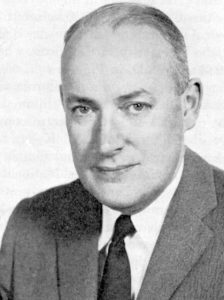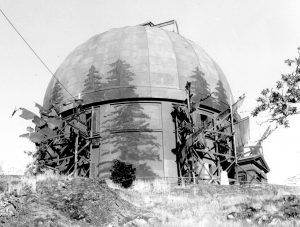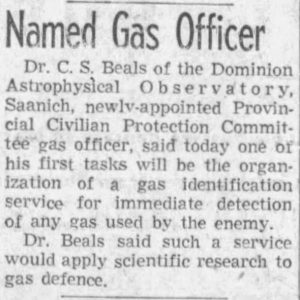The DAO during the Second World War
Canada entered the Second World War on September 10, 1939. Activity at the observatory decreased as the war effort increased, but scientific work continued throughout the war. Fundamental studies of the chemical and physical properties of stars predominated, along with radial velocity and temperature measurements of stars used as markers of the structure of the Milky Way. Important work on the chemical analysis of molecules in comets also continued.

Dr. Andrew McKellar was a brilliant researcher at the DAO. In 1939 he became a research officer for the Royal Canadian Navy. He attained the rank of lieutenant commander, all the while pursuing his astronomy work and publishing several significant scientific articles. He received an M.B.E. for his Second World War work.
The most notable work of this era was conducted by Andrew McKellar. During the war years, McKellar began his work on carbon stars. These are stars which have more carbon than oxygen in their atmospheres. McKellar’s work helped establish the carbon-nitrogen-oxygen cycle of nuclear fusion in stars by the late 1940s.
In 1940, McKellar also proved the existence of diatomic, carbon-based molecules in interstellar space and measured their temperature to be 3 degrees Kelvin. This non-zero temperature of interstellar space was a mystery. McKellar had discovered evidence for the Big Bang but no one realized this because the Big Bang Theory did not exist yet. In 1964, astronomers Arno Penzias and Robert Wilson rediscovered the temperature by other means, for which they were awarded the 1978 Nobel Prize for Physics. Unfortunately, the prize is only awarded to the living, and McKellar died in 1960.
The observatory’s white dome is a prominent landmark located 10 km north of the largest navy base on Canada’s west coast. In 1940, the dome had to be camouflaged. First it was painted brown, and it later was covered in a green forest mural.

During the Second World War the dome was camouflaged to prevent its use as a navigation point by enemy planes. The dome remained camouflaged until mid-1946 as it couldn’t be painted during the winter months.
The technical and scientific skill of the staff proved valuable to the war efforts. DAO astronomers taught celestial navigation to navy and air force officers, and artillery physics to army officers. Celestial navigation is still taught to recruits at CFB Esquimalt. The expertise of DAO astronomers in the chemistry of the heavens proved useful. Astronomers Carlyle Smith Beals and Robert Methven Petrie trained provincial officials on the detection of poisonous gasses. Beals was named the provincial gas officer and held many public talks on preparing for a gas attack. They issued over 400 training certificates to officers.

Many DAO staff did work related to the war effort during the Second World War. In coastal areas small respirators were made available to the public at a cost of $1.25.
Dr. McKellar also designed an aluminizing tank for the Plaskett Telescope in 1940. Yarrow Shipyards in Esquimalt built the tank and it is still in use today. Coating the mirror with aluminum rather than silver provided many advantages. The telescope was able to observe fainter stars as the mirror was more reflective. Maintenance of the aluminum coating was also easier than with the previous silver one. The aluminumizing tank was used to coat mirrors for searchlights and signalling mirrors for the war effort. McKellar and Pearce helped improve the design and maintenance of those military mirrors.
During the war, Petrie and McKellar transferred to the Navy with the rank of Lieutenant Commander. They both made important contributions to anti-submarine warfare in the Atlantic.
Before the war, the DAO had been receiving an average of 21,000 visitors per year. During the war, this number decreased to 4,000 per year, half of whom were military personnel. One factor was gasoline rationing, which limited travel. Saturday night visits ceased altogether as staff left for the war effort. These visits resumed in September 1945, at the end of the war.

